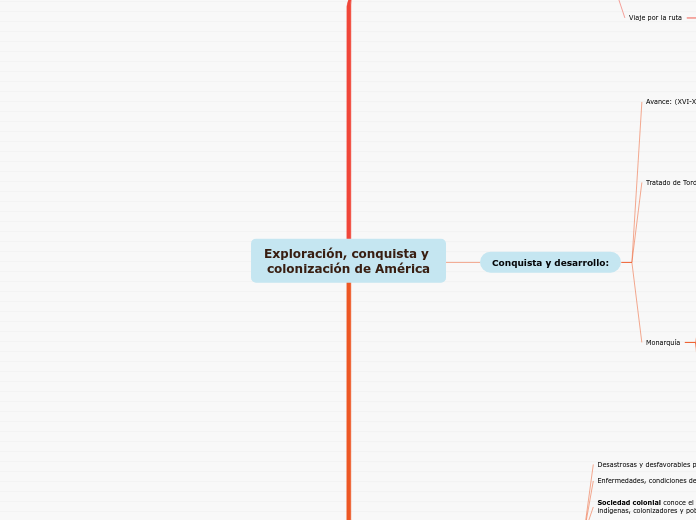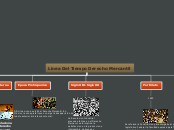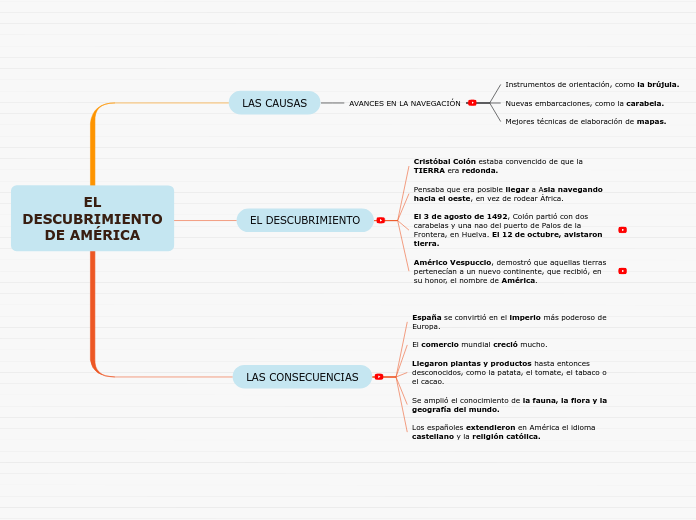Exploración, conquista y colonización de América
To name your story, you have to think about the overall message and what you want your audience to understand from the story. Also, make it relevant and easy to remember.
Consecuencias:
The ending of a story is essential. We all know that if the ending is weak, what happened before loses its importance. So make it unpredictable, but fair. A resolved ending answers all the questions and ties up any loose threads from the plot.
Tren la patata, el tomate, el tabaco, el maíz y el cacao...
Más costumbres y representaciones culturales
Difusión del cristianismo
Criollos: puestos de administración y riquieza
Lengua castellana: idioma común
Sociedad colonial conoce el mestizaje (mezcla de indígenas, colonizadores y población africana)
Sociedad desigual
Mundo multirracial y diverso
Enfermedades, condiciones de trabajo, guerras...
Desastrosas y desfavorables para los indígenas
This is the closure section of the story.
See examples of possible outcomes below:
- all problems have been solved
- it's clear how each one of your characters ends up
- your main character is transformed by the challenge
Conquista y desarrollo:
The middle of the story is where you add layers of complications that will lead to the end. Reveal more about the character's journey. Did their personality go through changes? How did they overcome the challenges? And as you build up the story’s central conflict, make it more personal to that character. Also, from the middle act, you have to lead into the final act.
Monarquía
There wouldn't be any tension and excitement in your story if there weren't any obstacles in your character's way.
Instalan virreinatos (XVI) - Arriba Gobernaciones o capitanías generales - Abajo
Crea la Administración:
Control tráfico de mercancías y personas -> Casa de Contratación (1503), en Sevilla
Recaudación tributos reales
Consejo de Indias (1524)
Control de dominios americanos -> Castilla
Leyes nuevas (1542) para proteger a los indios
Fuente de ingresos
A story is nothing more than a character overcoming a series of difficulties to reach the desired goal. Obstacles usually create suspense and conflict. In overcoming obstacles, there is growth: weak becomes strong; hatred turns into love; sadness into happiness; wrong into right; lies into truth; or evil becomes good.
See a few examples below:
- stopping a meteor
- finding a killer
- finding love
Actividades agropecuarias
Minería
Mita: Trabajo forzoso que se articulaba mediante sorteos
Propiedad real y explotación dada a los particulares
Comercio
A causa de la corona gracias a la Casa de Contratación, en Sevilla.
Monopolizado
Tratado de Tordesillas (1494)
Your character(s) need(s) motivation in order to solve the challenge(s).
Conquista
Secondary characters might also have motives that lead them to cross paths with the main character or which might trigger them to help the main character.
2º etapa: Francisco Pizarro
Inicia conquista Imperio Inca (1533)
Se dirige a las costas del Ecuador
1º etapa: Hernán Cortés
Se expande por Centroamérica (Guatemala y Honduras)
Conquista México (1521)
Lo firma Portugal y permite a España la expansión del continente americano.
Why does your character need to confront this challenge? What does he/she expect to accomplish by solving it?
See a few examples:
- will marry in 3 days
- can fix the mistakes of the past
Avance: (XVI-XVII)
Each story has a main character and that character usually needs to solve a problem or challenge. The character's challenge is the one that creates tension throughout the story.
+ Colonización
+ Conquista
Type in any other challenges which other characters in the story need to face.
+ Explotación
In most stories, there are 3 challenges. The number 3 is a mystical number symbolizing completeness. Try to come up with interesting challenges with which your character needs to struggle.
See a few examples below:
- turns into a werewolf at night
- is sent back in time
Exploración y causas:
In the beginning of the story (or the exposition), you will need to introduce the setting and characters. You might also want to introduce the main conflict. This part of the story is important because it gives the reader necessary background information and maybe even a first insight into a character’s personality.
Viaje por la ruta
The setting (time & place) of a story can change throughout the plot.
Se esperan encontrar con la India
Pero se encuentran con un territorio que no conocían habitado por indígenas
Salida y llegada
Sensory details include sight, sound, touch, smell, and taste. These details are important because they create depth in your setting.
See a few examples below:
- the smell of fresh bread
- the scent of freshly cut grass
- rain falling onto the windshield etc.
Desembarcan el 12 de octubre de 1492
Embarcan 3 de Agosto
Portugal + Castilla
Characters are essential to a good story. Usually, the protagonist(s) is/are the most affected by the plot. Introduce a character by focusing on their actions, interests, and occupation, as the physical appearance doesn't make a difference in most cases.
Buscan oro y especias
Cristobal Colón propone un idea basada en la esfericidad de la Tierra. (Ruta por el oeste)
Aceptan la idea, y firman la Capitulación de Santa Fe. Que agrupa los cargos y beneficios de la ruta.
Quieren hacer ruta a Asia por el Mediterráneo
Type in the name of your character.










